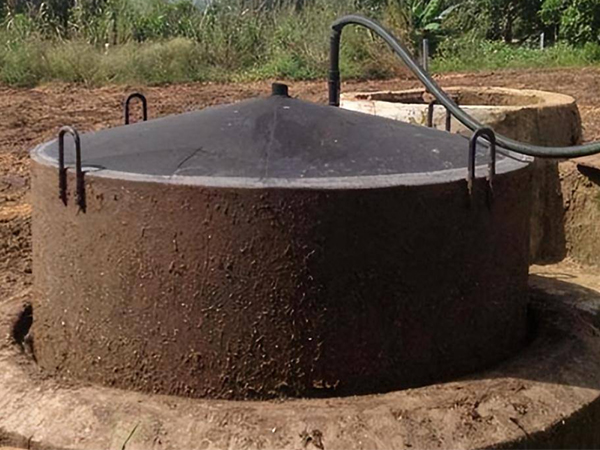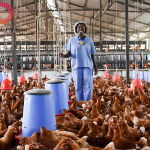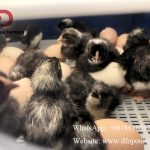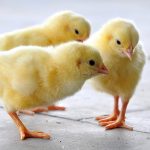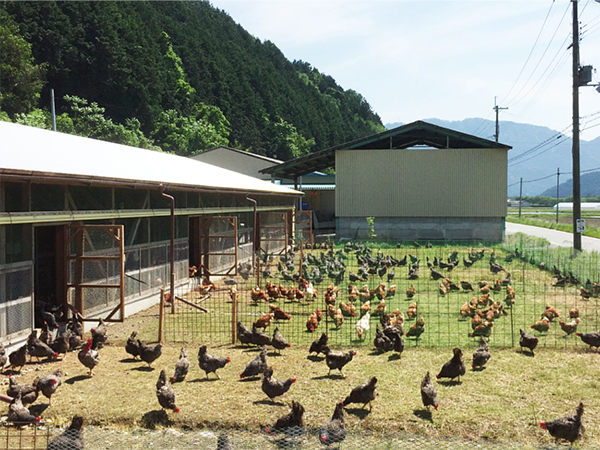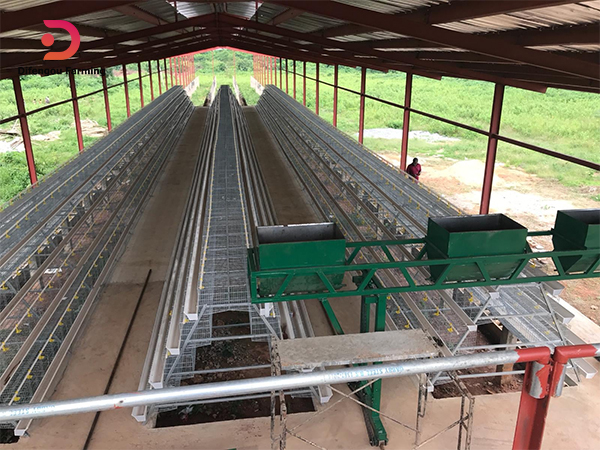The Digestive System of Chickens
The Digestive System of Chickens
The digestive system of chickens is composed of the mouth, esophagus, crop, proventriculus, gizzard, intestines, cloaca, and digestive glands (pancreas and liver). The structure and digestive process of chickens are significantly different from those of livestock.
1. Mouth
The mouths of chickens have no lips, teeth, or soft palate, so they do not chew. Chicken beaks are sharp and hard, which are suitable for eating granular feed. They can also tear large pieces of food, break open eggshells, and catch insects. The tongue is relatively hard, and the tongue mucosa has no taste buds. The number of taste buds in chickens is less than that in livestock (8 in day-old chicks and 14 in three-month-old chickens), so their sense of taste is not sensitive. When the taste buds come into contact with three types of water-soluble solutions: salty, bitter, and acidic, the tongue nerve produces impulses, but it lacks the sense of sweetness. Chickens are extremely sensitive to water temperature and do not like to drink water that is higher than the air temperature, but they do not refuse to drink cold water. Nesting hens do not mind drinking water that contains feces.
2. Esophagus and Crop
The esophagus of chickens is located on the right side of the trachea and is more expandable than that of livestock, so it can swallow larger pieces of food. The esophagus is divided into two parts: the upper esophagus (neck segment) and the lower esophagus (chest segment). The mucous membrane of the esophagus has esophageal glands, which secrete mucus to moisten and soften food. Before the upper esophagus enters the chest cavity, its ventral side expands to form a bulge called the crop. The crop is a temporary storage place for food. The saliva and esophageal mucus mixed with the food keep the ingested feed at a suitable temperature and humidity. The food is softened and fermented by the bacteria that enter with the food. The contraction rhythm and amplitude of the crop vary greatly, affected by a variety of factors such as the nervous state, hunger level, feed type, and quantity. When chickens are extremely excited, scared, or struggling, the contraction of the crop can be suppressed or stopped. Normally, the inter-contraction period of the upper and lower esophagus is about 13 seconds and 50-55 seconds, respectively. Through contraction, the food is sent to the stomach. When the crop and stomach are full of food, the esophagus stops peristalsis, and when more food is ingested, it is stored in the crop. Food stays in the crop of chickens for 3-4 hours, at most up to 16-18 hours. When chickens are hungry, the food stays in the crop for a very short time. The crop of healthy chickens should be full, soft, and not bloated. A variety of diseases and improper management can cause crop impaction, bloating (gas sac), or water accumulation (water sac), which can be used to judge the health of chickens.
Figure 2-1 Digestive tract of chickens
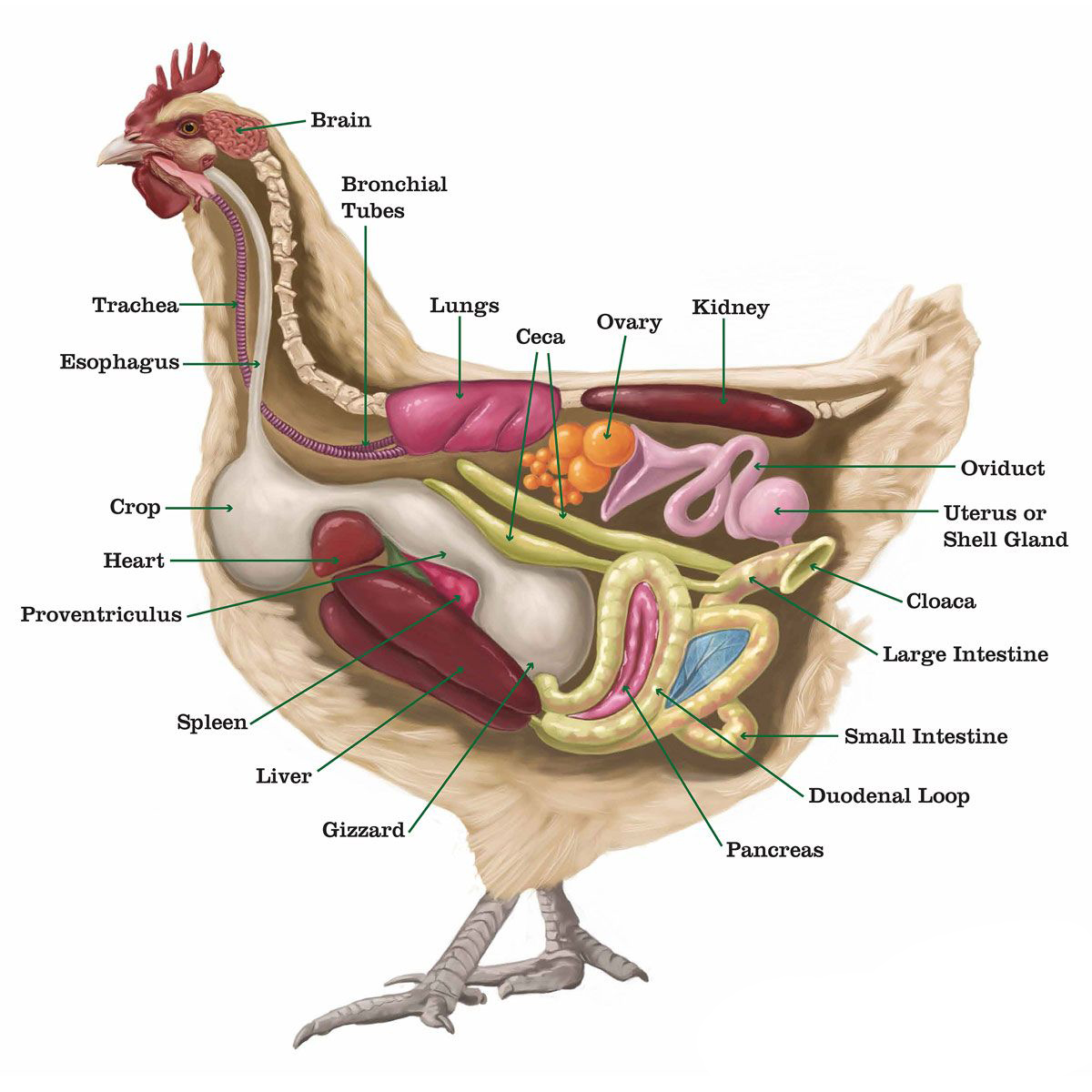
3. Stomach
The chicken’s stomach is divided into two parts: the anterior glandular stomach and the posterior muscular stomach.
The anterior glandular stomach is a spindle-shaped organ with a soft and thick wall. It secretes gastric acid and pepsin. The food mixed with the gastric juice immediately enters the posterior muscular stomach.
The posterior muscular stomach is a flattened, round organ. The thick yellow keratinous membrane on the mucosa protects the mucosa (this membrane can be used as medicine, known as chicken gizzard). The muscular stomach often contains swallowed gravel, so it is also called the grit sac. The muscular stomach grinds and mixes food through the gravel and the strong contraction of the developed muscles (the contraction pressure is 13.3-19.6 kPa). Gastric pepsin continues to act here. If there is no gravel in the muscular stomach, the feed digestibility can be greatly reduced. Therefore, gravel should be fed to chickens during the brooding and growing periods. Fine and soft food stays in the muscular stomach for 1 minute and then enters the duodenum, while hard food can stay for several hours.
4. Intestinal Tract
The intestinal tract is divided into small intestine (duodenum, jejunum, and ileum) and large intestine (cecum and rectum). The small intestine secretes intestinal juice, and bile and pancreatic juice secreted by the liver and pancreas flow into the duodenum through the bile duct and pancreatic duct, respectively. In the small intestine, under the joint action of various digestive enzymes in pancreatic juice and intestinal juice, and bile, most of the nutrients in the feed are digested into simple forms (glucose, peptides, amino acids, fatty acids, and glycerol), and then absorbed by the intestinal mucosa. Within 15 minutes after feeding, carbohydrate and protein breakdown products (glucose and amino acids) appear in the portal vein blood, but the peak of absorption is after 2 hours.
In the junction of small intestine and rectum, there is a pair of cecums about 10 centimeters long. Only 6% to 8% of the substances passing through the small intestine enter the cecum. The undigested carbohydrates, proteins, and a small amount of fiber substances (mainly from grains) flowing into the cecum are fermented and digested by the action of microorganisms. Part of the fermentation products are absorbed, and water and major minerals such as sodium, potassium, chloride, and calcium (see the mineral section of this chapter) can also be absorbed here. Chickens have low digestion capacity for crude fiber, so the crude fiber content in the feed should be 3% to 5%. However, if the crude fiber content is too low, the intestinal peristalsis is not sufficient, and it is easy to develop bad habits such as feather picking and pecking. The substances in the cecum are porridge-like, thick and uniform, and mostly chocolate-colored. The contents are emptied every 6 to 8 hours (the small amount of light brown feces seen in chicken manure is cecal feces). The rectum is the last section of the large intestine, where the water and electrolytes of food residues are absorbed again, and then enter the cloaca.
In comparison to livestock, the small intestine of poultry is shorter (about 140 cm), which is about 5 to 6 times the length of the body, and the rectum is only 8 to 10 cm (which is 1/14 of the small intestine). This is because birds (poultry are also birds in the bird class) have adapted to flying by reducing weight and not storing feces in the intestine. Therefore, the length of time it takes for feed to pass through the digestive tract varies depending on the type, shape, and physiological condition of the poultry. For example, it takes about 4 hours for growing chickens and laying hens to pass feed through their digestive tract, about 8 hours for resting hens, and 12 hours for nesting hens.
The digestive tract of poultry is home to a large number of non-pathogenic microorganisms (bacteria, etc.). The digestive tract of newly hatched chicks is sterile, but it quickly becomes infected with microorganisms from eggshell fragments or other foreign objects in the incubator, and then continues to be acquired from feed and water. The proventriculus contains a large number of lactobacilli, as well as enterococci and aerobic bacteria. The strong acidic environment (pH 2 to 4) in the glandular stomach and muscular stomach is not conducive to the growth and reproduction of microorganisms. When the intestinal contents approach the junction of the ileum and cecum, the intestinal contents move very slowly and the pH is suitable, allowing microorganisms to multiply in large numbers. The pH in the cecum is 6.5 to 7.5, and the contents are only emptied every few hours, which is an ideal environment for the growth and reproduction of microorganisms.
5. Cloaca
The cloaca is the common channel for the terminal ends of the digestive, urinary, and reproductive systems, namely the urethra, cloaca, and anus. The side wall of the anus has the supracloacal sac (cloacal bursa), whose function is related to immunity.

